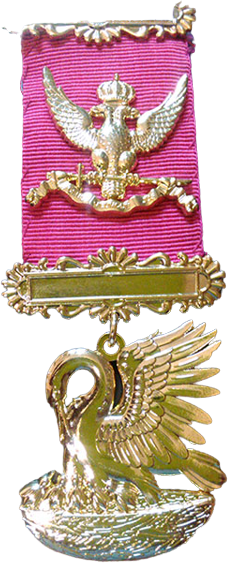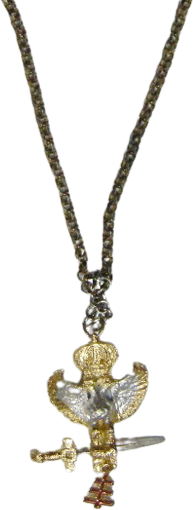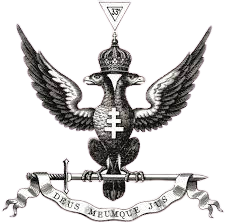18° Collar

18° Jewel

Most Wise Sovereign Collarette & Jewel

Past Most Wise Sovereign Breast Jewel

The Collar jewel for the 18th Degree Rose Croix, is an open, crowned compasses, the limbs of the compass open to 60°, resting on a quadrant, or segment of a circle. The compasses are crowned. The jewel has a reverse and an obverse. Resting on the quadrant is an eagle in silver with its head lowered. Its wings are open but not spread. Above the eagle is a passion cross in crimson. On the obverse, resting on the quadrant is the nest of a pelican, originally containing seven hatchlings. Perched on the edge of the nest is the pelican, piercing her breast with her beak. It was anciently believed that the pelican tore her breast to nourish her young with her own blood. Thus the pelican became a symbol of self-sacrifice, philanthropy, and devotedness. It also symbolized the bounty of nature, from which all living things draw their sustenance. The main symbol featured on this beautiful gold jewel of course is the mother Pelican pecking her breast to feed her babies.
The pelican feeding her young with her blood is a prominent symbol of the Eighteenth or Rose Croix Degree of the Ancient and Accepted Scottish Rite, and was adopted as such from the fact that the pelican, in ancient Christian art, was considered as the emblem of the Savior. This symbol without any modification has also been adopted by the Supreme Council of the Ancient and Accepted Rite 33o of India. Now this symbolism of the pelican, as a representative of the Savior, is almost universally supposed to be derived from the common belief that the pelican feeds her young with her blood, as the Savior shed his blood for mankind; and hence the bird is always represented as sitting on her nest, and surrounded by her brood of young ones, who are dipping their bills into a wound in their mother's breast.
But this is not the exact idea of the symbolism, which really refers to the resurrection, and is, in this point of view, more applicable to Christ, as well as to the Masonic Degree of which the resurrection is a doctrine. In an ancient Bestiarium, or Natural History, in the Royal Library at Brussels, cited by
Larwood and Hotten in a recent work on the History of Signboards, this statement is made: "The pelican is very fond of her young ones, and when they are born and begin to grow, they rebel in their nest against their parent, and strike them with their wings flying about them, and beat them so much till they wound them in their eyes. Then the father strikes and kills them. And the mother is of such a nature that she comes back to the nest on the third day, and sits down upon her dead young ones, and opens her side with her bill and pours her blood over them, and so resuscitates them from death; for the young ones, by their instinct, receive the blood as soon as it comes out of the mother, and drink it." Dr. Mackey believed the true theory of the pelican is, that by restoring her young ones to life by her blood, she symbolizes the resurrection. The old symbologists said, that the male pelican, who destroyed his young, represents the serpent, or evil principle, which brought death unto the world; while the mother, who resuscitates them, is the representative of the Son of Man of whom it is declared, "except ye drink of His blood, ye have no life in you." Hence the pelican is very appropriately a symbol of Freemasonry, whose great object it is to teach by symbolism the doctrine of the resurrection, and especially in that sublime Degree of the Ancient & Accepted Rite wherein, the old Temple being destroyed and the old Word being Lost, a new temple and a new word spring forth -- all of which is but the great allegory of the destruction by death and the resurrection to eternal life.The compasses carry their usual Masonic interpretation of spiritual awareness and self-control.
The compasses are crowned to symbolize the fact that the Mason highest in rank or Degree is only the highest among his equals. The crown also symbolizes the sovereignty of the people and the rights of self-government and self-determination. The eagle on the jewel symbolizes Supreme Wisdom and Intelligence, deriving that meaning from the ancient Egyptians who remarked that the eagle's wings bore
him high toward the light and away from the clouds. Thus the eagle and pelican, together, symbolize, respectively, perfect wisdom and perfect devotedness.The cross, which is part of the design on both sides, is an ancient symbol of infinity and has been used as a sacred symbol from early antiquity—far predating Christianity. Thus it may be said to represent the world or the condition of the world. It also has ancient associations with suffering and sacrifice. Thus the cross on the Chamber of Darkness side of the jewel can be taken to represent the world in suffering when the Word was lost. The rose has ancient associations with dawn, and thus with hope and a new awakening to life. The cross with rose on the Chamber of Light side of the jewel thus represents immortality won by suffering and sorrow.
The association with immortality is strengthened by the addition of the sprig of acacia at the base of the cross. All of these symbols point, of course, to the transformation of the world with the discovery of the New Law of Love. That Law of Love redefines life and our responsibilities to others. It is no longer sufficient to say, "I have done no harm." We no longer have the excuse of ignorance if we choose to "pass by on the other side." Life becomes a positive affirmation of the worth of others and oneself. It is this Law which transforms and directs the raw spirituality of the 17° by giving it shape and focus and mission. It teaches the great lesson of the Brotherhood of Mankind under the Fatherhood of God. It affirms that your obligation is to each person, simply because he or she is a person. It insists that our common humanity, our common "sonship," is more important than any divisive consideration—more important than nationality, creed, race, social position, or wealth. Banished forever from the lips of a Knight Rose Croix are the words, "God, I thank thee, that I am not as other men are" (Luke 8:11), for we know we are, in all that matters, like them indeed.


























